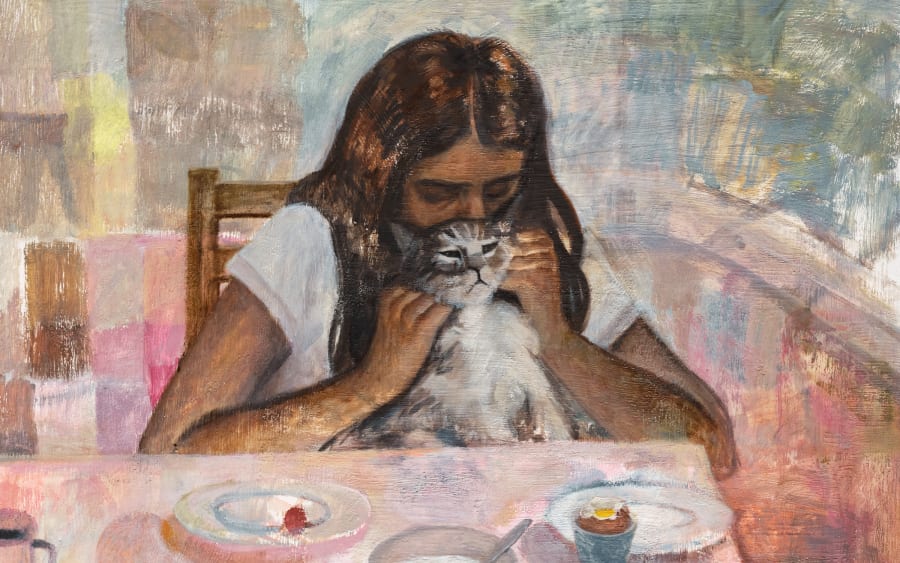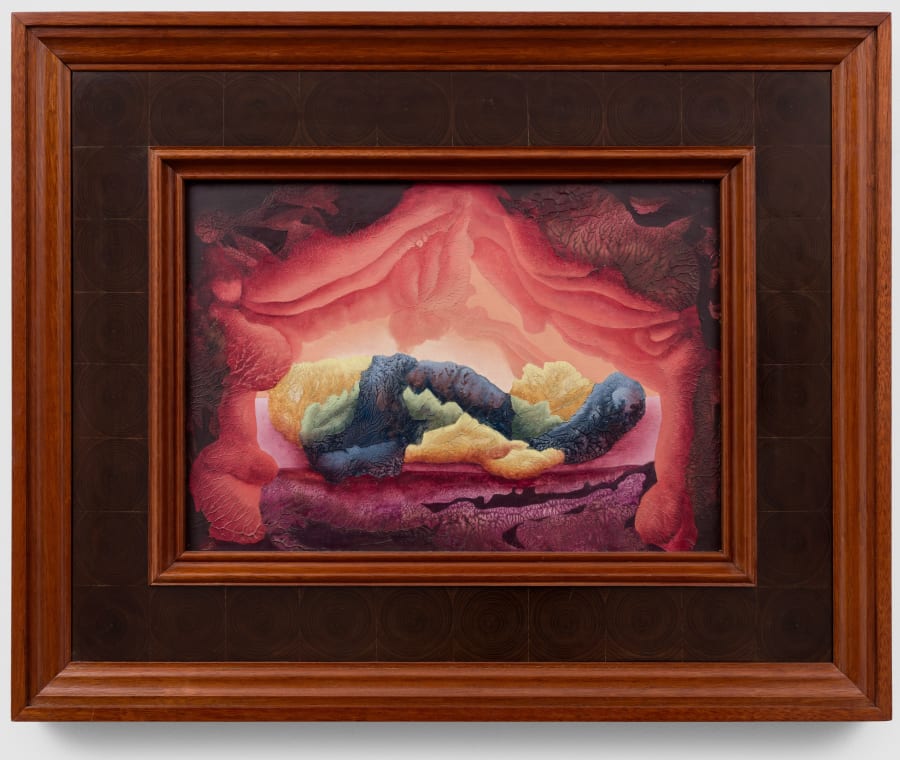In Suzanne Valadon’s La Chambre bleue (The Blue Room, 1923), a woman reclines on her unmade bed, staring into space, a cigarette between her lips. The model’s pose recalls that of odalisques, those lascivious-looking harem women often painted nude. Valadon, however, chooses to subvert these traditions. Firstly, the woman is clothed: wearing striped pants and a camisole with double straps, which lends the canvas a surprising air of modernity. Secondly, she is not an object but a subject: with one hand casually resting on her thigh, she seems caught in a moment of reverie or reflection, perhaps inspired by the books that lie at her feet. She pays no attention to our gaze – in fact, at any moment, she might light her cigarette, get up, and walk away.
La Chambre bleue is one of the masterpieces in the major retrospective dedicated to Valadon opening this month at the Centre Pompidou in Paris, following a first iteration at Centre Pompidou-Metz in 2023. The painting captivates the audience with its beauty and the expressiveness of its brushwork, but also through Valadon’s empathetic gaze upon her model. The artist bestows upon her female subject a presence and freedom rarely found in the canvases of her contemporaries.
Valadon was one of just a few female artists among the Parisian avant-garde who haunted the cabarets of Montmartre in the late 19th century. Although she achieved some success during her lifetime, her work has long been overlooked within art history. She was confined instead to her male relationships: a model for the great painters of Modernism; lover of Erik Satie, among others; and mother of the painter Maurice Utrillo, whose work found its own place in art history. Yet this working-class, self-taught artist left behind a remarkable body of work – 500 paintings and 300 works on paper – both nourished by the trends of her time and resolutely free.
Suzanne Valadon was born in 1865 as Marie-Clémentine Valadon, to a washerwoman mother and unknown father. A child of the heights of Montmartre, which were then part countryside and part shantytown, she worked various odd jobs: waitress, vegetable seller, weaver of funeral wreaths. But it was bohemian Montmartre that attracted her. She aspired to be an equestrian and an acrobat, but a fall forced her to abandon the circus.
She was 15 when she became Maria, the model. Noticed for her acrobatic prowess in the arena and her charismatic beauty, she posed for the masters of the day: We find her laughing in Pierre-Auguste Renoir’s Les Grandes Baigneuses (The Great Bathers, 1884-87); leaning on the bar in Henri de Toulouse-Lautrec’s Gueule de Bois (The Hangover, 1887-89); and in many of the figures in Pierre Puvis de Chavannes’s Bois sacré cher aux arts et aux muses (Sacred Grove Beloved by the Arts and Muses, 1884).
But what they didn’t know was that Valadon had been drawing avidly since childhood. It was Toulouse-Lautrec who, discovering her drawings, encouraged her to show them to a certain Edgar Degas. The latter fell under the charm of her line, both ‘hard and subtle,’ and encouraged her to continue her practice.
To sign her first work, a charcoal and pastel Autoportrait (Self-Portrait) from 1883, she chose Suzanne – a biblical nickname ironically given by Toulouse-Lautrec to this woman who posed nude for these old painters. The gesture asserted her transition from model to artist. At this time she primarily drew, exercising her thick and expressive line in everyday nude scenes, and she began to learn engraving. She used her mother as a model, but also her young son, Maurice, born in 1884, also to an unknown father.
She exhibited for the first time in 1893 at the Galerie Le Barc de Boutteville, and in 1894 at the Société Nationale des Beaux Arts, both in Paris. Two years later, she married Paul Mousis, a wealthy stockbroker. Together with her mother and son, they settled at 12 rue Cortot at the top of the hill in Montmartre, where Valadon finally had a studio where she would work until her death. (A reconstruction of the studio is part of the current Musée de Montmartre.) In these new comfortable surroundings, she devoted herself to painting but produced relatively little during this period.
In 1909, she divorced Mousis and began a relationship with the young André Utter, a friend of her son, whom she married in 1914. It is he who stands near her in the Garden of Eden in Adam et Eve (1909), joining his hand with hers to pick the forbidden fruit. Valadon entered a prolific period and exhibited regularly at the Salon d’Automne and with the gallerist Berthe Weill, who supported her from 1912. Playing with conventions, she continued to paint male nudes inspired by her new muse, like the epic Le Lancement du filet (Casting the Net, 1914) – works which caught the attention of critics.
The paintings of this period show a new maturity. Her emphasized and sinuous line that outlines her figures’ silhouettes recalls that of Paul Cézanne, while her fauve, saturated palette evokes that of Paul Gauguin – one of the few influences she herself would acknowledge. Her approach, however, finds a sincere resonance with that of another forgotten figure of art history, her German contemporary Paula Modersohn-Becker. Both painted ‘real women...stripped of the male gaze,’ as Marie Darrieussecq wrote in her 2016 book, Being Here is Splendor: The Life of Paula M. Becker.
Whether using anonymous models or her own reflection, Valadon painted women of all ages and all body types with a constant desire to capture their truth, without idealizing or hiding anything. Whether they are washing, lying down, getting dressed, having their cards read, dreaming, or returning our gaze, they always appear free and in full control of their bodies.
In her remarkable Autoportrait au miroir (Self-Portrait with Mirror, 1927), for example, the artist depicts herself at the age of 62 without pretense, with strong features and drooping shoulders. As subject her gaze is weary but uncompromising, disillusioned but empathetic – just like the gaze she has turned upon herself.
It is this quest for truth, as well as Valadon’s fierce determination to reinvent herself outside established conventions, that resonates with particular intensity today. It finds an echo in the works of many women artists who came after her: from Maria Lassnig’s probing self-portraits to the engaged portraits of Alice Neel, from Jenny Saville’s representation of female bodies to Lisa Brice’s feminist revisitations of masterpieces from Western art history – indeed Brice is an artist who openly cites Valadon as an inspiration.
‘My work? It is finished, and the only satisfaction it gives me is never having betrayed or compromised on anything I believed in,’ Valadon told the writer Francis Carco shortly before she died in 1938. ‘You will see it perhaps, one day, if someone ever cares to do me justice.’
‘Suzanne Valadon’
From January 15 until May 26, 2025
Centre Pompidou, Paris
Louise Darblay is a writer, editor, and translator based in Paris.
English translation: Art Basel.
Caption for header image: Suzanne Valadon, La Chambre bleue, 1923. Gift by Joseph Duveen, 1926. Paris, Centre Pompidou, Musée national d’art moderne, LUX.1506 P, on deposit at musée des Beaux-Arts de Limoges. Credit: Centre Pompidou, MNAM-CCI/Jacqueline Hyde/ Dist. GrandPalaisRmn.
Published on January 14, 2025.


